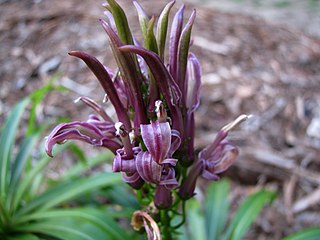
Gaillardia is a genus of flowering plants in the family Asteraceae, native to North and South America. It was named after Maître Gaillard de Charentonneau, an 18th-century French magistrate who was an enthusiastic botanist. The common name may refer to the resemblance of the inflorescence to the brightly patterned blankets made by Native Americans, or to the ability of wild taxa to blanket the ground with colonies. Many cultivars have been bred for ornamental use.

Hemidactylus is a genus of the common gecko family, Gekkonidae. It has 191 described species, newfound ones being described every few years. These geckos are found in all the tropical regions of the world, extending into the subtropical parts of Africa and Europe. They excel in colonizing oceanic islands by rafting on flotsam, and are for example found across most of Polynesia. In some archipelagoes, cryptic species complexes are found. Geckos like to live in and out of houses. They have been introduced to Australia.

Urtica dioica, often known as common nettle, burn nettle, stinging nettle or nettle leaf, or just a nettle or stinger, is a herbaceous perennial flowering plant in the family Urticaceae. Originally native to Europe, much of temperate Asia and western North Africa, it is now found worldwide, including New Zealand and North America. The species is divided into six subspecies, five of which have many hollow stinging hairs called trichomes on the leaves and stems, which act like hypodermic needles, injecting histamine and other chemicals that produce a stinging sensation upon contact.

Ceanothus is a genus of about 50–60 species of nitrogen-fixing shrubs and small trees in the buckthorn family (Rhamnaceae). Common names for members of this genus are buckbrush, California lilac, soap bush, or just ceanothus. "Ceanothus" comes from Ancient Greek: κεάνωθος (keanōthos), which was applied by Theophrastus to an Old World plant believed to be Cirsium arvense.

The desert woodrat is a species of pack rat native to desert regions of western North America.

Charles Christopher Parry was a British-American botanist and mountaineer.

Linanthus is a genus of annual and perennial plants in the phlox family Polemoniaceae. The species are found in western North America and in Chile, with the greatest diversity in California.

Jennifer Odessa Nettles is an American singer, songwriter, actress and record producer.

The Hawaiian lobelioids are a group of flowering plants in the bellflower family, Campanulaceae, subfamily Lobelioideae, all of which are endemic to the Hawaiian Islands. This is the largest plant radiation in the Hawaiian Islands, and indeed the largest on any island archipelago, with over 125 species. The six genera involved can be broadly separated based on growth habit: Clermontia are typically branched shrubs or small trees, up to 7 metres (23 ft) tall, with fleshy fruits; Cyanea and Delissea are typically unbranched or branching only at the base, with a cluster of relatively broad leaves at the apex and fleshy fruits; Lobelia and Trematolobelia have long thin leaves down a single, non-woody stem and capsular fruits with wind-dispersed seeds; and the peculiar Brighamia have a short, thick stem with a dense cluster of broad leaves, elongate white flowers, and capsular fruits. The relationships among the genera and sections remains unsettled as of April 2022.

Astereae is a tribe of plants in the family Asteraceae that includes annuals, biennials, perennials, subshrubs, shrubs, and trees. They are found primarily in temperate regions of the world. Plants within the tribe are present nearly worldwide divided into over 250 genera and more than 3,100 species, making it the second-largest tribe in the family behind Senecioneae.

Stephanomeria is a genus of North American plants also known as wirelettuce, belonging to the tribe Cichorieae within the family Asteraceae.

Loasaceae is a family of 15–20 genera and about 200–260 species of flowering plants in the order Cornales, native to the Americas and Africa. Members of the family include annual, biennial and perennial herbaceous plants, and a few shrubs and small trees. Members of the subfamily Loasoideae are known to exhibit rapid thigmonastic stamen movement when pollinators are present.

Eucnide urens, also known as desert rock nettle or desert stingbush, is a shrub which is native to desert areas in California, Arizona, Utah, Southern Nevada, and Baja California. Other common names are velcro plant and vegetable velcro.

Pipturus is a flowering plant genus in the nettle family, Urticaceae.

The Black Rock Desert volcanic field in Millard County, Utah, is a cluster of several volcanic features of the Great Basin including Pahvant Butte, The Cinders, and Tabernacle Hill. The field's Ice Springs event was an explosive eruption followed by lava flows that were Utah's most recent volcanic activity. which overlapped the older flows of Pavant Butte.

Cornish Yarg is a semi-hard cow's milk cheese made in Cornwall, United Kingdom. Before being left to mature, the cheese is wrapped in nettle leaves to form an edible, though mouldy, rind. The texture varies from creamy and soft immediately under the nettle coating to a Caerphilly cheese-like crumbly texture in the middle.
















